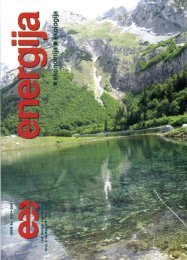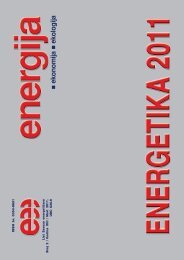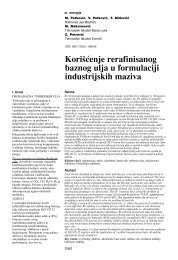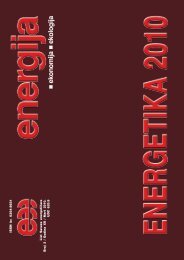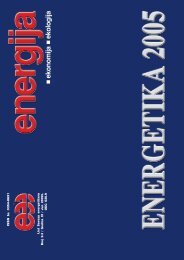ekonomija
2009-5
2009-5
- No tags were found...
Create successful ePaper yourself
Turn your PDF publications into a flip-book with our unique Google optimized e-Paper software.
energijaenergy) seem to have been more attractivefor exploitation than solar energy,[1,4]. The share of energy producedfrom the solar radiation in total world’senergy production is at the momentjust about 0.1%.To be competitive with other renewableand traditional power engineering,solar photovoltaic engineering musthave certain performance characteristics,mainly rely on and associatedwith the installation specific cost, theconversion efficiency and service lifeof solar power stations and effectivefull-power hours of operation.Having in mind that the resources ofsolar energy are huge and practicallyendless, accessible to every countryand almost absolutely harmless and environmentallyand ecologically clean,the expected future improvements inthe solar technology and engineeringpromise that the goal should bemeet soon, perhaps in a few incomingdecades. The photovoltaic, or solar,energy will in a future be an indispensablepart of the energy system inalmost every country.An inevitable questions we have toface with are: where is the place ofthe Serbian energetic and industrysector in comparison with world’sand EEC’s renewable solar energytrends, and what are the key issues andfactors which have to be reached andimproved to allow the Serbian energysector to cope with modern and futuresolar energy challenges. With a verysmall portion of installed renewableenergy capacities from the total energyproduction, the answers should havebe pretty pessimistic, however, therecent changes in the government andadministrative course and policy, aswell as increased business interests inthe renewable energy engineering andinvestments, might lead us towardssome promising and optimistic tonesand forecasts.The aim of this paper is to reviewsome fundamentals of photovoltaiccells and systems and to discuss thekey issues and essential factors determiningthe lines, potentials and prospectsof the solar power engineeringdevelopment worldwide, and particularlyin Serbia under new governmentpolicy conditions.2. Solar Energy and PhotovoltaicConversion - BasicHighlightsThe solar energy is the enormouselectromagnetic energy radiated by theSun and it is packed within the solarspectrum which can be approximatedby a black body radiation of 5900 0 K.The range of solar spectrum is verybroad: from the ultraviolet to the nearinfrared band, including the narrowvisible light portion.Electricity can be produced directlyfrom solar energy using a device calledphotovoltaic (PV) cell - also referredas a solar cell. When electrons of thesurface region of the semi conductingsolar cell (usually made of silicon, orsilicon alloys, obviously with incorporateda pn junction) absorb enoughenergy from photons (particles orquanta of the shining incident light),they separate from the atoms (leavethe valence energy band) and migrate(enter the conducting energy band) tothe front surface of the PV cell causingpotential difference between front andback surface of the cell (well-knownphotovoltaic effect, noticed anddescribed for the very first time by H.Becquerel in 1839., [1], and explainedlater by A. Einstein in 1905.). So, anelectric current could flow throughthe wire that connects front and backcell contacts as long as the solar lightexposure lasts. From the optoelectronicpoint of view, PV cell behaves like atypical semi conductor diode. Eachindividual cell only produces a smalldirect current (DC) voltage (around 1or 2 Volts), therefore they have to bejoined (connected in series) to createhigher and usable DC electricity withinthe PV device. Large groups of seriesconnected individual PV cells arecalled solar modules or arrays.The conversion efficiency, the mostimportant property of the solar cell, isthe ratio of the PV generated electricoutput power to the total electromagneticlight power radiated on the cell,and for today’s market available cellsis in the range 10 to 17%, however,module efficiencies are somewhatlower. The first silicon solar cells weredeveloped at Bell Laboratories in1954, while experimenting with semiconductors,and used in the late 1950sto provide the energy to operate spacesatellites; their efficiency was 6%, butvery soon#improved to 10%. Efficiencyof the todays optimally designedmodern high efficiency cells are wellabove 20%, [5-7]. Intensive nowadaysresearch in PV technology is characterizedby slow but steady improvementin cell conversion efficiency.It is worth to highlight and explainwhy the cell conversion efficiency iswell below 100% (total conversion).We have already mentioned, at thebeginning of this section, that solarwave spectrum is very broad, con-[060]sisting of the stream of photons withdifferent energies. The photon energyW phis represented via the frequency fof the “travelling photon” striking atthe cell surface as W ph=hf where h isthe Plank’s constant. Electrons withinatoms placed very near struck semiconductor cell surface can either be inthe valence energy level or band (withinatom) or “jump” to the conductingenergy level or band (bonds with atomare broken, electron can “travel” as anconducting particle). Those two energylevels are discrete values, different forevery specific atom or material. So,there is an energy difference or gap betweenthose two levels, in which therecan be no electrons. This energy gapW gis more often called the band gap.The photon can only reacts with electronand gives him own energy if itsenergy is at least equal to the electron’sband gap, W g#& W ph. It means that thesemi conductor is “transparent” onlyfor photons with energies over thespecific energy level, i.e. frequency,from the broad solar spectrum. Moreenergetic photons will deliver to theelectron only a part of the energy, therest being thermalized, and for weakerphotons the semi conductor cell is“opaque”, causing the photon reflectionfrom the cell surface. Therefore,the photon transparency, or the photonabsorption process, directly dependson the semi conductor band gap, andconsequently just a portion of the solarenergy spectrum can be absorbed withspecific semi conductor material. Theratio of this absorbed energy portionto the total solar energy within theradiated spectrum defines the PV cellefficiency. On the other hand, if thePV cell is exposed to monochromaticlight (for example the laser beam),with the radiation frequency matchingexactly the semi conductor’s band gap,the total conversion can theoreticallyoccurred with the 100% efficiency. Althoughthis photon-electron interactionmodel is very simplified, the holes andphonons exist as well, pn junctions,etc., (the passionate reader can consultthe Feynman’s QED - the brilliant andamazingly exact Quantum Electro-Dynamic theory of light and matterinteraction, if it helps!), it can serves asthe sufficiently clear explanation of theenergy absorbing process underneaththe semi conductor solar cell surface.Knowing the exact value for the semiconductor band gap and solar energydistribution function, we could calculatethe theoretical efficiencies for anyused semi conductor.Obviously, the photovoltaic mechanismsignificantly differs from one



